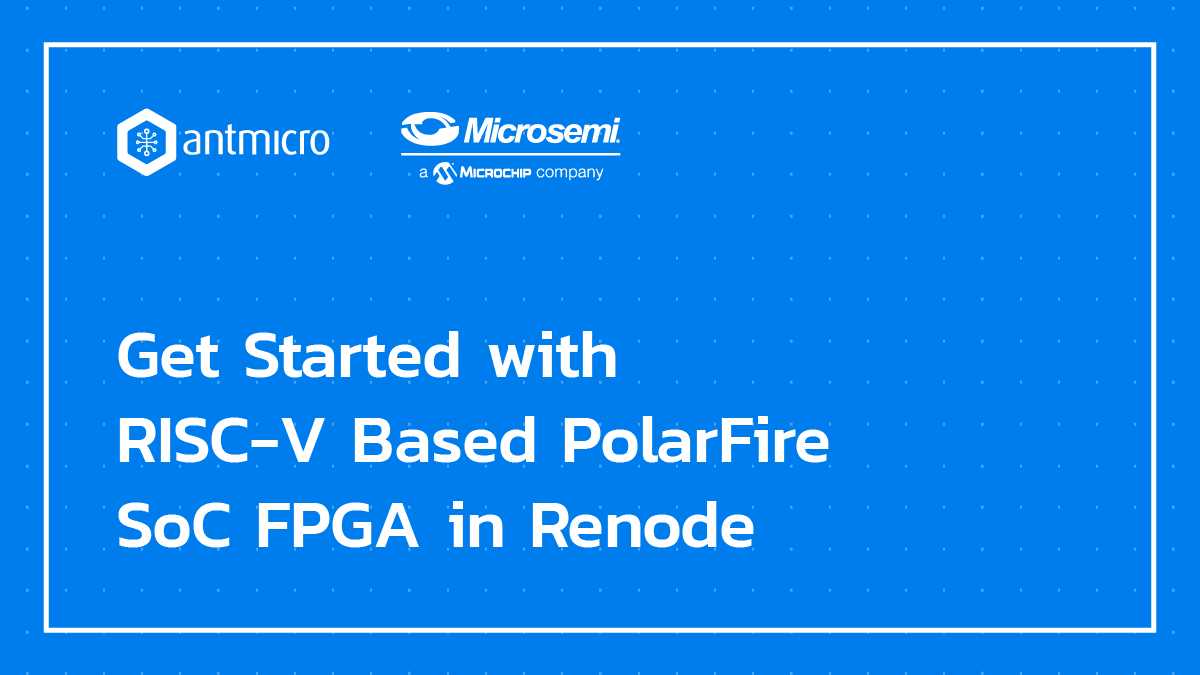Press Release: Learn to Get PolarFire SoC Designs Started with Antmicro’s Renode Development Framework and Microchip’s SoftConsole v6.0
Published:

Antmicro and Microchip hosting webinar series on how to use the free and open Renode platform to build systems targeting the RISC-V based PolarFire™ SoC FPGA architecture
MILPITAS, CA. – April 30, 2019 – Learn how to get started with the PolarFire SoC FPGA architecture, the world’s first RISC-V based SoC FPGA, to create fully deterministic, real-time systems alongside the Linux® operating system. Along with Microchip, Antmicro is holding a series of webinars to introduce you to the free and open Renode™ development platform that is available with the SoftConsole v6.0 software development environment. We’ll show you demo applications, how to create projects, and set up and configure your own systems targeting the new SoC FPGA architecture introduced at the RISC-V Summit in December.
The series kicks off on May 2, where Michael Gielda, VP Business Development of Antmicro will provide an overview of SoftConsole 6.0 with Renode integration. He will introduce you to the Renode development framework and provide an overview of the platform and its features. You will also learn about the PolarFire SoC architecture and how to use Renode to start pre-silicon development of your application.
“We’re excited to be teaming up with antmicro to deliver a comprehensive development environment for PolarFire SoC, which brings multi-core deterministic low power compute to deeply embedded and edge applications,” said Tim Morin, strategic marketing director at Microchip. “Developers can easily get started today using Antmicro’s free and open source Renode platform by downloading our SoftConsole v6.0 tool, and attending these ‘getting started’ webinars.”
“As Platinum Founding Members of the RISC-V Foundation, we are happy to see Renode becoming the golden standard for RISC-V development. Thanks to its commercially supported open source approach focused on real use cases, Renode is driving the new, software-oriented methodologies reinforcing the impact of breakthrough solutions like Microchip’s PolarFire SoC”, Michael Gielda, VP Business Development at Antmicro, explains.
Start prototyping PolarFire SoC-based systems with Renode today
In the upcoming weeks, join Antmicro and Microchip for six webinar sessions every first Thursday of the month to see how pre-silicon development in Renode can take your PolarFire SoC-based system to market faster. Read below for session descriptions, and click here to register.
Discover Renode for PolarFire™ SoC Design and Debug
In this introductory session, we will provide you with an overview of SoftConsole 6.0 with Renode integration. We will introduce you to the Renode development framework and provide an overview of the platform and its features. You will also learn about the PolarFire SoC architecture and how to use Renode to develop your application.
How to Get Started with Renode for PolarFire SoC
In Session 2, we will show you how to get started with the Renode development platform. We’ll walk through the installation of SoftConsole 6.0 on the Windows® operating system, as well as several flavors of the Linux operating system, and discuss how to resolve any installation issues. Once installation is complete, you will learn how to launch and run the included demo programs and verify your SoftConsole 6.0 installation and Renode set up.
Learn to Debug a Bare-Metal PolarFire SoC Application with Renode
In Session 3, we will show you the pse-blinky demo example that emulates a PolarFire SoC system in the Renode development platform with five available harts. You’ll learn how to configure the debug session and how to connect to the hart. We will demonstrate the configuration of the UART analyzer and individual peripherals, then run the example project and simultaneously debug on multiple harts in separate debug sessions.
Tips and Tricks for Even Easier PolarFire SoC Debug with Renode
In Session 4, we will recap what has been covered in previous sessions and answer questions that have been raised after each session. We will then demonstrate common Renode commands and command syntax and provide an explanation and example of available logging levels. You’ll also learn how to configure SoftConsole launch groups and how to create and use macros for Renode. We will also discuss the primary differences between Renode and Silicon.
Add and Debug PolarFire SoC Peripherals with Renode
In Session 5 you will learn how to add local memory to a Renode system and execute code. From there, we’ll cover the creation and addition of a timer to the system to create interrupts. A GPIO will then be added, followed by the set up and configuration of MonoDevelop, which is used to create peripherals for Renode. We’ll then create a custom UART that will be added to the system to be compiled just in time.
Intro to PolarFire SoC MSS Configuration and Software Flow
In Session 6, we will cover the embedded software development flow for the PolarFire SoC. We will describe the hardware-level configuration for the microprocessor subsystem, memory configuration, logical separation for security and boot processes and how they integrate into a classic embedded software development flow.
About Antmicro
Antmicro (www.antmicro.com) is a software-driven tech company developing advanced open source-based cyber-physical and edge AI systems. Antmicro provides open software, hardware, tooling, new development methodologies and applied R&D to customers worldwide, accelerating new product development and adoption of modern computing platforms, both CPU/ASIC, GPU and FPGA-based. A Platinum Founding Member of the RISC-V Foundation, Antmicro supports, uses, contributes to and helps promote a broad range of open source technologies such as RISC‐V, Tensorflow, Zephyr, Linux and Android. Antmicro are the authors of Renode and offer commercial support, integrated automated testing environments and new platform development services for the open source framework.
